2013 PEUGEOT 3008 seats
[x] Cancel search: seatsPage 119 of 352
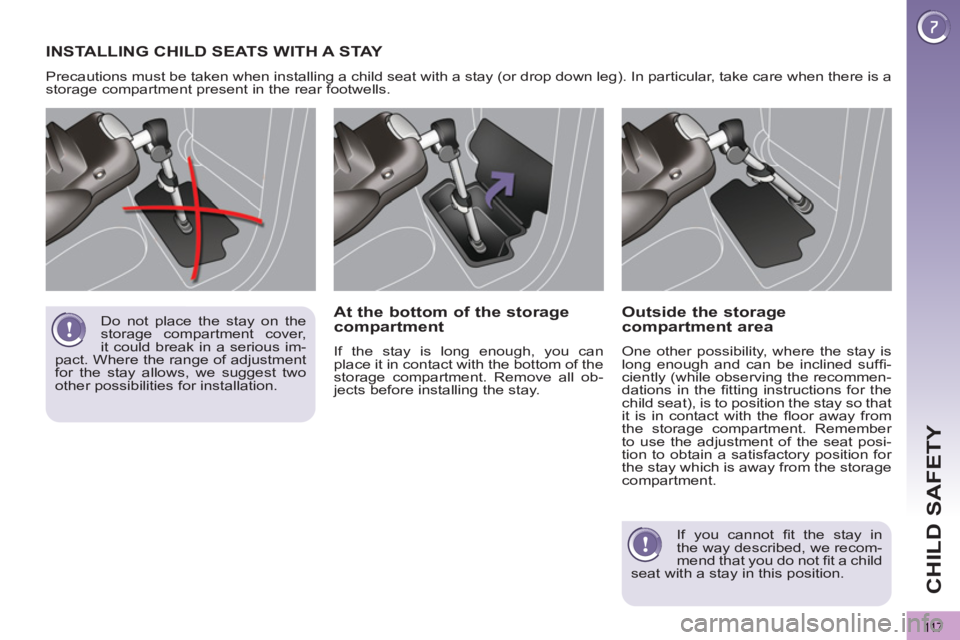
11 7
CHILD SAFETY
INSTALLING CHILD SEATS WITH A STAY
Precautions must be taken when installing a child seat with a stay (or drop down leg). In particular, take care when there is a
storage compartment present in the rear footwells.
Do not place the stay on the
storage compartment cover,
it could break in a serious im-
pact. Where the range of adjustment
for the stay allows, we suggest two
other possibilities for installation.
At the bottom of the storage
compartment
If the stay is long enough, you can
place it in contact with the bottom of the
storage compartment. Remove all ob-
jects before installing the stay.
Outside the storage
compartment area
One other possibility, where the stay is
long enough and can be inclined suffi -
ciently (while observing the recommen-
dations in the fi tting instructions for the
child seat), is to position the stay so that
it is in contact with the fl oor away from
the storage compartment. Remember
to use the adjustment of the seat posi-
tion to obtain a satisfactory position for
the stay which is away from the storage
compartment.
If you cannot fi t the stay in
the way described, we recom-
mend that you do not fi t a child
seat with a stay in this position.
Page 120 of 352
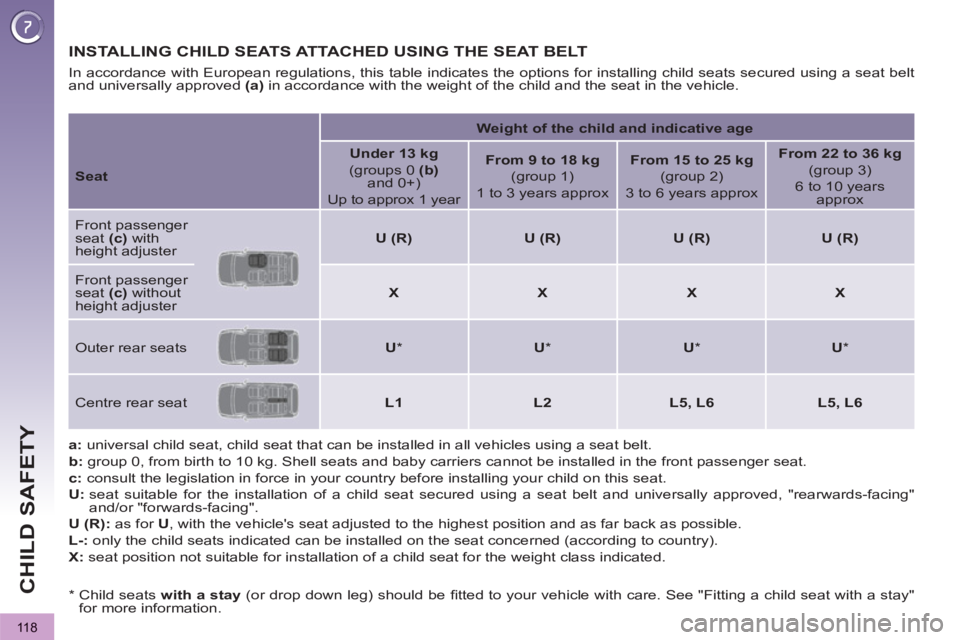
118
CHILD SAFETY
INSTALLING CHILD SEATS ATTACHED USING THE SEAT BELT
a:
universal child seat, child seat that can be installed in all vehicles using a seat belt.
b:
group 0, from birth to 10 kg. Shell seats and baby carriers cannot be installed in the front passenger seat.
c:
consult the legislation in force in your country before installing your child on this seat.
U:
seat suitable for the installation of a child seat secured using a seat belt and universally approved, "rearwards-facing"
and/or "forwards-facing".
U (R):
as for U
, with the vehicle's seat adjusted to the highest position and as far back as possible.
L-:
only the child seats indicated can be installed on the seat concerned (according to country).
X:
seat position not suitable for installation of a child seat for the weight class indicated.
In accordance with European regulations, this table indicates the options for installing child seats secured using a seat belt
and universally approved (a)
in accordance with the weight of the child and the seat in the vehicle.
*
Child seats with a
stay
(or drop down leg) should be fi tted to your vehicle with care. See "Fitting a child seat with a stay"
for more information.
Weight of the child and indicative age
Seat
Under 13 kg
(groups 0 (b)
and 0+)
Up to approx 1 year
From 9 to 18 kg
(group 1)
1 to 3 years approx
From 15 to 25 kg
(group 2)
3 to 6 years approx
From 22 to 36 kg
(group 3)
6 to 10 years
approx
Front passenger
seat (c)
with
height adjuster
U (R)
U (R)
U (R)
U (R)
Front passenger
seat (c)
without
height adjuster
X
X
X
X
Outer rear seats
U
*
U
*
U
*
U
*
Centre rear seat
L1
L2
L5, L6
L5, L6
Page 121 of 352
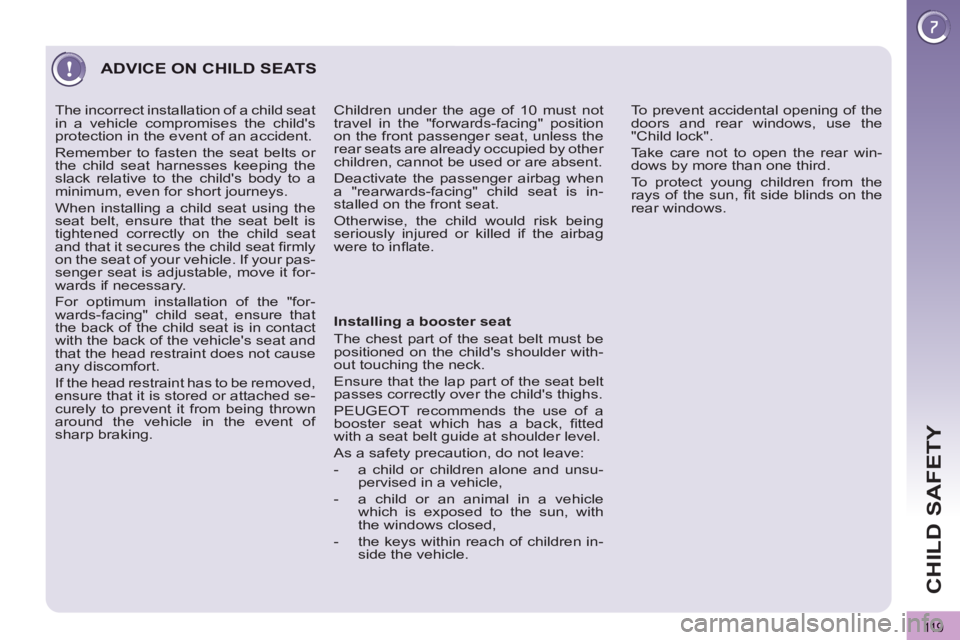
119
CHILD SAFETY
ADVICE ON CHILD SEATS
Installing a booster seat
The chest part of the seat belt must be
positioned on the child's shoulder with-
out touching the neck.
Ensure that the lap part of the seat belt
passes correctly over the child's thighs.
PEUGEOT recommends the use of a
booster seat which has a back, fi tted
with a seat belt guide at shoulder level.
As a safety precaution, do not leave:
- a child or children alone and unsu-
pervised in a vehicle,
- a child or an animal in a vehicle
which is exposed to the sun, with
the windows closed,
- the keys within reach of children in-
side the vehicle. To prevent accidental opening of the
doors and rear windows, use the
"Child lock".
Take care not to open the rear win-
dows by more than one third.
To protect young children from the
rays of the sun, fi t side blinds on the
rear windows.
Children under the age of 10 must not
travel in the "forwards-facing" position
on the front passenger seat, unless the
rear seats are already occupied by other
children, cannot be used or are absent.
Deactivate the passenger airbag when
a "rearwards-facing" child seat is in-
stalled on the front seat.
Otherwise, the child would risk being
seriously injured or killed if the airbag
were to infl ate. The incorrect installation of a child seat
in a vehicle compromises the child's
protection in the event of an accident.
Remember to fasten the seat belts or
the child seat harnesses keeping the
slack relative to the child's body to a
minimum, even for short journeys.
When installing a child seat using the
seat belt, ensure that the seat belt is
tightened correctly on the child seat
and that it secures the child seat fi rmly
on the seat of your vehicle. If your pas-
senger seat is adjustable, move it for-
wards if necessary.
For optimum installation of the "for-
wards-facing" child seat, ensure that
the back of the child seat is in contact
with the back of the vehicle's seat and
that the head restraint does not cause
any discomfort.
If the head restraint has to be removed,
ensure that it is stored or attached se-
curely to prevent it from being thrown
around the vehicle in the event of
sharp braking.
Page 122 of 352
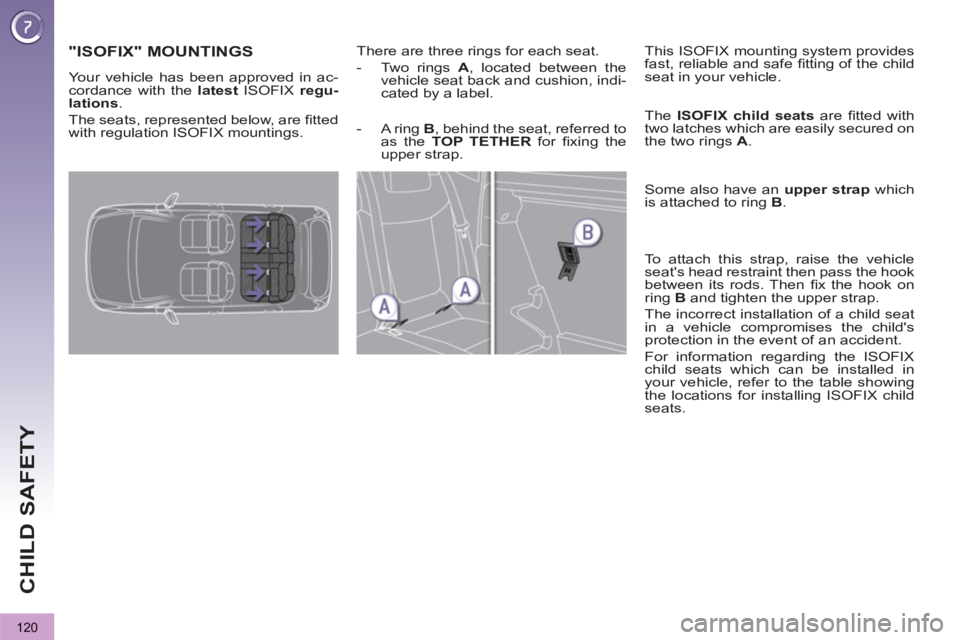
120
CHILD SAFETY
"ISOFIX" MOUNTINGS
There are three rings for each seat.
- Two rings A
, located between the
vehicle seat back and cushion, indi-
cated by a label.
This ISOFIX mounting system provides
fast, reliable and safe fi tting of the child
seat in your vehicle.
The ISOFIX child seats
are fi tted with
two latches which are easily secured on
the two rings A
.
Some also have an upper strap
which
is attached to ring B
.
To attach this strap, raise the vehicle
seat's head restraint then pass the hook
between its rods. Then fi x the hook on
ring B
and tighten the upper strap.
The incorrect installation of a child seat
in a vehicle compromises the child's
protection in the event of an accident.
For information regarding the ISOFIX
child seats which can be installed in
your vehicle, refer to the table showing
the locations for installing ISOFIX child
seats.
Your vehicle has been approved in ac-
cordance with the latest
ISOFIX regu-
lation
s
.
The seats, represented below, are fi tted
with regulation ISOFIX mountings.
- A ring B
, behind the seat, referred to
as the TOP TETHER
for fi xing the
upper strap.
Page 123 of 352
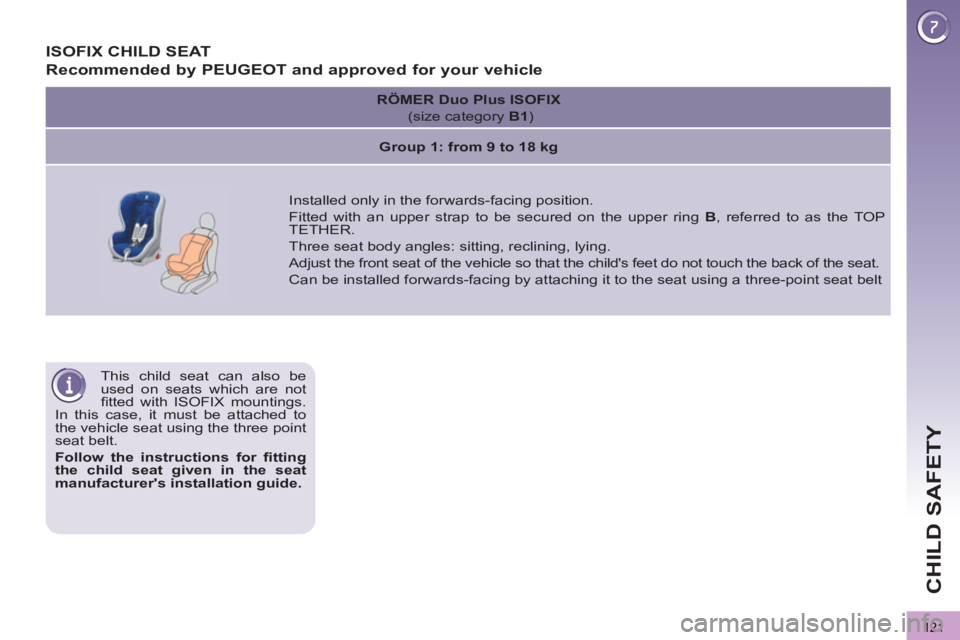
121
CHILD SAFETY
This child seat can also be
used on seats which are not
fi tted with ISOFIX mountings.
In this case, it must be attached to
the vehicle seat using the three point
seat belt.
Follow the instructions for fi tting
the child seat given in the seat
manufacturer's installation guide.
ISOFIX CHILD SEAT
Recommended by PEUGEOT and approved for your vehicle
RÖMER
Duo Plus ISOFIX
(size category B1
)
Group 1: from 9 to 18 kg
Installed only in the forwards-facing position.
Fitted with an upper strap to be secured on the upper ring B
, referred to as the TOP
TETHER.
Three seat body angles: sitting, reclining, lying.
Adjust the front seat of the vehicle so that the child's feet do not touch the back of the seat.
Can be installed forwards-facing by attaching it to the seat using a three-point seat belt
Page 124 of 352

122
CHILD SAFETY
LOCATIONS FOR INSTALLING ISOFIX CHILD SEATS
IUF:
seat suitable for the installation of an I
sofi x U
niversal seat, " F
orwards-facing" secured using the top belt.
IL-SU:
seat suitable for the installation of an I
sofi x S
emi- U
niversal seat either:
- "rearwards-facing" fi tted with a top belt or a stay,
- "forwards-facing" fi tted with a stay,
- a shell seat fi tted with an upper strap or a stay.
For advice on securing the top belt, refer to the section on "Isofi x mountings".
X:
seat not suitable for the installation of a child seat or shell for the weight group indicated.
In accordance with European Regulations, this table indicates the options for installing ISOFIX child seats on seats in the
vehicle fi tted with ISOFIX mountings.
In the case of universal and semi-universal ISOFIX child seats, the ISOFIX size category, determined by a letter from A
to G
,
is indicated on the child seat next to the ISOFIX logo.
*
Child seats with a
stay
(or drop down leg) should be fi tted to your vehicle with care. Refer to the section on fi tting a child
seat with a stay.
Weight of the child
/ indicative age
Less than 10 kg
(group 0)
Up to approx.
6 months
Less than 10 kg
(group 0)
Less than 13 kg
(group 0+)
Up to approx. 1 year
From 9 to 18 kg (group 1)
From approx. 1 to 3 years
Type of ISOFIX child seat
Shell
"rearwards-facing"
"rearwards-facing"
"forwards-facing"
ISOFIX size category
F
G
C
D
E
C
D
A
B
B1
Front passenger seat
X
X
X
X
Outer rear seats
X
IL-SU
*
IL-SU
*
IUF
*
IL-SU *
Centre rear seat
X
X
X
X
Page 132 of 352
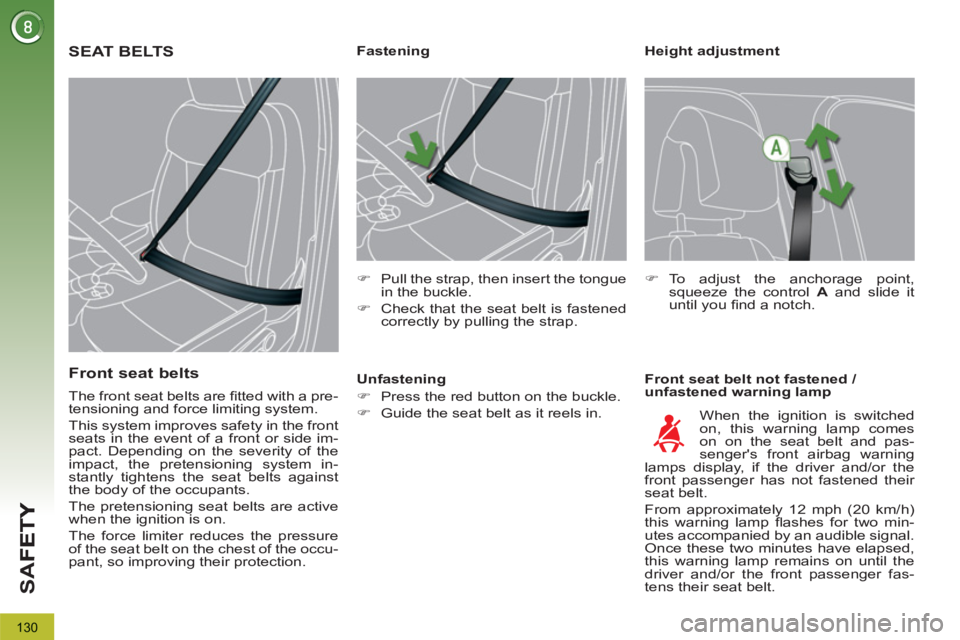
130
SA
F
Height adjustment
Front seat belt not fastened /
unfastened warning lamp
Fastening
�)
Pull the strap, then insert the tongue
in the buckle.
�)
Check that the seat belt is fastened
correctly by pulling the strap.
�)
To adjust the anchorage point,
squeeze the control A
and slide it
until you fi nd a notch.
When the ignition is switched
on, this warning lamp comes
on on the seat belt and pas-
senger's front airbag warning
lamps display, if the driver and/or the
front passenger has not fastened their
seat belt.
From approximately 12 mph (20 km/h)
this warning lamp fl ashes for two min-
utes accompanied by an audible signal.
Once these two minutes have elapsed,
this warning lamp remains on until the
driver and/or the front passenger fas-
tens their seat belt.
Unfastening
�)
Press the red button on the buckle.
�)
Guide the seat belt as it reels in.
SEAT BELTS
Front seat belts
The front seat belts are fi tted with a pre-
tensioning and force limiting system.
This system improves safety in the front
seats in the event of a front or side im-
pact. Depending on the severity of the
impact, the pretensioning system in-
stantly tightens the seat belts against
the body of the occupants.
The pretensioning seat belts are active
when the ignition is on.
The force limiter reduces the pressure
of the seat belt on the chest of the occu-
pant, so improving their protection.
Page 133 of 352

131
SA
F
1.
Front and/or rear seat belts not fas-
tened / unfastened warning lamp.
2.
Front left seat belt warning lamp.
3.
Front right seat belt warning lamp.
4.
Rear right seat belt warning lamp.
5.
Rear centre seat belt warning lamp.
6.
Rear left seat belt warning lamp.
Seat belt not fastened / unfastened
warning lamps display
Rear seat belts
The rear seats are each fi tted with a
three-point inertia reel seat belt with
force limiter (with the exception of the
centre rear seat).
Seat belt unfastened warning lamp
This warning lamp comes on on
the seat belt and passenger's
front airbag warning lamps dis-
play, when one or more rear
passengers unfasten their seat belt.
From approximately 12 mph (20 km/h),
this warning lamp fl ashes for two min-
utes accompanied by an audible signal.
Once these two minutes have elapsed,
this warning lamp remains on until the
one or more rear passengers fasten
their seat belt.
Fastening
�)
Pull the strap, then insert the tongue
in the buckle.
�)
Check that the seat belt is fastened
correctly by pulling the strap.
Unfastening
�)
Press the red button on the buckle.
�)
Guide the seat belt as it reels in.
The corresponding warning lamp 2
or 3
comes on in red on the seat belt and
passenger's front airbag warning lamps
display if the seat belt is not fastened or
is unfastened.
When the ignition is switched on, with
the engine running or when the vehicle
is moving at less than 12 mph (20 km/h),
the corresponding warning lamps 4
, 5
and 6
come on in red for approximately
30 seconds, if the seat belt is not fas-
tened.
When the vehicle is moving at more
than 12 mph (20 km/h), the correspond-
ing warning lamp 4
, 5
or 6
comes on
in red, accompanied by an audible sig-
nal and a message on the multifunction
screen, if a rear passenger has unfas-
tened their seat belt.
Seat belt unfastened warning
lamps display